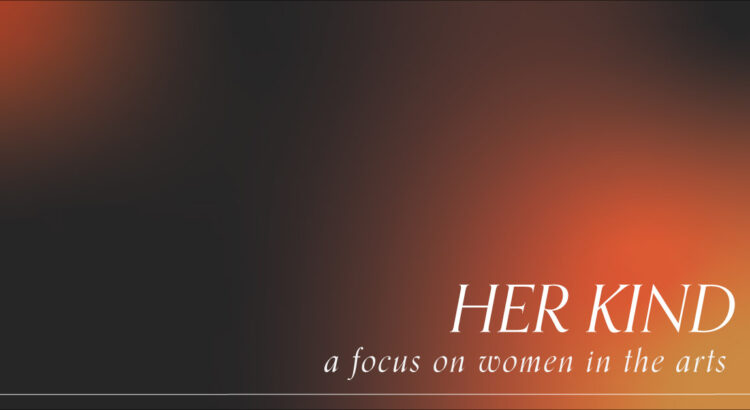Welcome to her kind!
Welcome to her kind—a new column at arts, ink. that takes a closer look at women in the arts: their works, their influence, and their history. This column will feature a different artist each week, and we’ll be covering a wide variety of disciplines, from poetry to visual arts to composition. The title of this column comes from Anne Sexton’s poem of the same name.
My name is Nicole Knorr; I’m a composer/pianist pursuing my Master’s degree here at the University of Michigan. I wanted to start a column on women in the arts for two reasons: I get to research and find wonderful work to feature, and I get to host a platform where women’s art is celebrated and brought to readers’ attention. To go along with the blog, I’ve created a Spotify playlist (here) so you all can listen to the work featured, and those of you who perform might find some repertoire to take on someday.
I’m looking forward to sharing some of my favorite art with you all, and I’m excited to host a space where we can celebrate fantastic art together, so cheers! As artist and professor Joan Semmel put it:
‘…if there are no great celebrated women artists, that’s because the powers that be have not been celebrating them, but not because they are not there.’
Germaine Tailleferre

This week, I want to start with one of my favorite composers: Germaine Tailleferre. I discovered Tailleferre a few years ago while looking for piano repertoire for the semester. I chose her Pastorale, and for the first time, I studied a piece that wasn’t written by a guy. Yes—after studying piano for over ten years, I hadn’t played a single piece of music by a woman—so Tailleferre holds a special place in my heart.
Tailleferre lived from 1892-1983 and grew up in fin-de-siecle Paris. She was the only female member of Les Six, a group of French composers who rejected both Wagner’s dramaticism and Debussy’s impressionism. They were interested in composing music for everyday—music the average listener could enjoy—while still maintaining technical rigor and prowess.
Her pre-war period was her most prolific—her catalogue of this era boasts a comic opera, a violin concerto, several songs, and the scores for seven films. When Tailleferre fled to the Pennsylvania during the 1940’s due to WWII, she married artist Ralph Barton, who disapproved of her composing career, so her musical output steeply declined. It wasn’t until she decided to divorce Barton and return to France in 1946 that she began composing again, but once she did, she built up her catalogue significantly.

The piece I’d like to highlight is Tailleferre’s piano concerto. It’s a highly effective piece, and I’m excited to share it with you, so let’s dive in!
The work premiered in December 1924 to a highly positive critical response. Tailleferre was hailed as a progressive; Stravinsky himself said of the concerto, “It is virtuous music!” The piece blends Tailleferre’s French roots with Baroque figurations and perhaps even some American influence. While she does follow Les Six’s ideology of composing “everyday music,” or music for the working class (no more Wagnerian drama or elaborate Debussian orchestrations), no one can deny the pristine clarity and rigor of the work—despite being accessible to the average audience.
The piece opens with a lively first movement—the strings and piano in conversation, then upper winds join, and finally Tailleferre turns our ear to the brass. One can hear the influence of Bach here, the motive is passed seamlessly between voices, and there is hardly a moment of reprieve. I was struck by the cadence capping the first movement; it’s Coplandesque–reminiscent of what one might hear in his Rodeo suite.
Of the slow movement, pianist Alfred Cortot says “Voilà qui n’est pas moins beau que Bach” (Here’s

something no less beautiful than Bach). Similar to the first, the music presses onward with little space provided for rest. This maintains a steady sense of momentum, in true baroque fashion. The orchestration fills out over time. Tailleferre begins with the stark upper register of the solo piano,sparsely harmonized—the upper winds slowly filter in, then the strings add warmth as the piano’s lower register is introduced. There is an insistent pedal point occurring in the piano part for much of the piece to build tension. The piece unfolds into a densely orchestrated climax and falls away into the same register it began—this time supported by a few more members of the orchestra.
The third movement is a jubilant celebration. The rhythmic motor returns, accompanied by modal mixture, a staple in the Les Six vocabulary. This movement display’s Tailleferre’s affection for contrapuntal rigor—an effective closing for the work.
I hope you get a chance to listen and enjoy Tailleferre’s music as much as I do. You can listen to my favorite selections of Tailleferre’s music in this playlist, or you can scan her Spotify barcode below and explore for yourself. In the future, I’ll be adding a bit more of a reactive element in my blog posts—sketches inspired by the art discussed. Thanks for reading, and I hope you’ll join me next week!





Leave a Reply
Be the First to Comment!